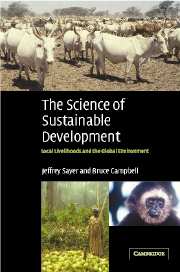Book contents
- Frontmatter
- Contents
- List of figures
- List of boxes
- List of tables
- Foreword
- Preface
- Acknowledgements
- Part I Integrating natural resource management
- Part II Realities on the ground
- 6 Institutions for managing natural resources in African savannas
- 7 Forest margins in Indonesian Borneo
- 8 Learning by doing on tropical American hillsides
- Part III The research–management continuum
- Bibliography
- Index
8 - Learning by doing on tropical American hillsides
Published online by Cambridge University Press: 18 May 2010
- Frontmatter
- Contents
- List of figures
- List of boxes
- List of tables
- Foreword
- Preface
- Acknowledgements
- Part I Integrating natural resource management
- Part II Realities on the ground
- 6 Institutions for managing natural resources in African savannas
- 7 Forest margins in Indonesian Borneo
- 8 Learning by doing on tropical American hillsides
- Part III The research–management continuum
- Bibliography
- Index
Summary
The natural forests of the hillsides of the Andean Mountains in central and northern South America are reputed to contain higher diversities of flora and fauna than any other forests in the world. They also protect the watersheds of the rivers that provide water for the countries of the region. However, these same hillsides are also major producers of food: 40% of the food produced in the Andean countries comes from hillside agriculture. They provide for the livelihoods of most of the rural poor of the countries from Peru to El Salvador. Hillside agro-ecosystems cover 96 million hectares in the region and similar land types extend into Brazil; 25 million hectares are already highly degraded and an additional 53 million hectares are experiencing rapid rates of erosion and deforestation. Some degree of erosion is seen on 50% of the hillsides of Colombia and 83% of the Andean region as a whole. Central America is said to have the region's highest proportion of its land with moderate to extreme erosion. And the situation is getting worse. The large farmers in the valleys are expanding their holdings and peasant farmers – the campesinos – are forced into the hills. The associated evils of drug production and trafficking and politically motivated banditry further erode the security of the lives of the people of this region.
- Type
- Chapter
- Information
- The Science of Sustainable DevelopmentLocal Livelihoods and the Global Environment, pp. 170 - 188Publisher: Cambridge University PressPrint publication year: 2003

